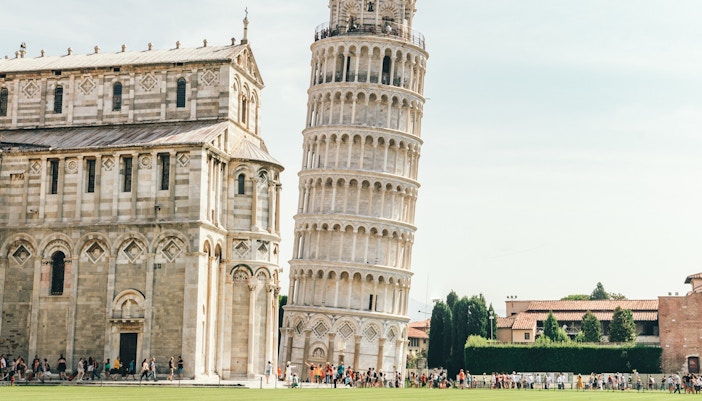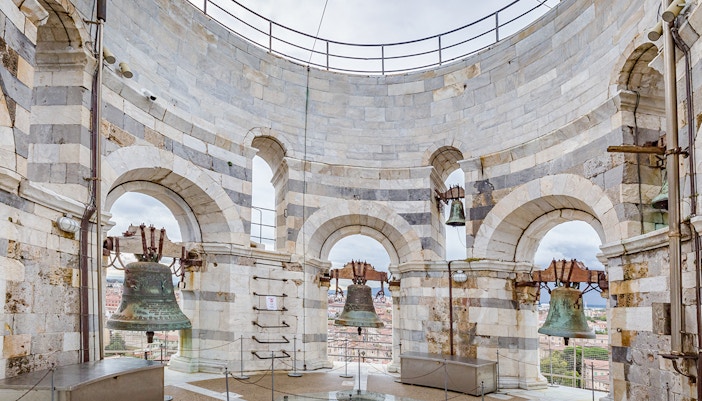Leaning Tower of Pisa Facts | 15 Things You Didn't Know About Pisa's Bell Tower
Overview

Italian name: Torre Pendente di Pisa
Location: Piazza del Duomo, 56126 Pisa PI, Italy
Height: 57 meters
Tilt: 3.97 degrees from the vertical
Architects: Bonanno Pisano, Gerardo di Gerardo, Giovanni Pisano, Giovanni di Simone
Year of Completion: 1399
Number of Steps: 251 spiral steps
Visit the Leaning Tower of PisaFacts About the Leaning Tower of Pisa

1. It was One of the 7 Wonders of the World
The title of the 'Wonders of the World' is usually awarded to one-of-kind structures that belonged to the ancient world. Despite being a reproduction of the Medieval ages, the Leaning Tower of Pisa was declared as one of the Seven Wonders of the World for its exceptional Romanesque architecture, its sheer size and because it miraculously leans while still holding still.

2. The Leaning Tower Tilts Because it was Built on Marshy Land
There's an interesting story to why the Leaning Tower of Pisa leans. Pisa, in fact, gets its name from a Greek word meaning “marshy land” owing to the terrain of the area. It is mainly made of clay. Surprisingly, the cathedral's architects decided to disregard the fact and still build this exceptionally tall structure with foundations only 3-meters deep on marshy lands!

3. The Leaning Tower was not Meant to be a Standalone Structure
Despite how famous the Leaning Tower of Pisa is by itself, it wasn’t meant to be a standalone structure. It is actually part of a bigger cathedral complex. One that features the Bell Tower, the Cathedral, the Baptistery and the Cemetery. The Leaning Tower of Pisa was the last element to be built on the site and in fact, represents the bell tower of the nearby marble Cathedral of Santa Maria Assunta.

4. The Cathedral and Baptistery are also Sinking
Due to the marshy nature of the soil, the cathedral and the baptistery are also sinking. This is despite the Campo Santo cemetery being built on sods of earth that were transported by ship from Jerusalem to Pisa.

5. It took Almost Two Centuries to Build it
All the architectural complications that sprung up throughout, the construction obviously meant delays in completion. By the time they reached the third story, the tower continued to lean, not knowing what to do next, the builders halted construction for almost a century. Along with this, between the years 1173 and 1372, the Republic of Pisa often joined important battles that forced the constructors to stop the works for long periods of time. It took an astounding 199 years to complete the Leaning Tower of Pisa.

6. The Engineer Working on the Tower’s Reclamation wasn’t an Expert in Soil Mechanics
Engineer John Burland who was in charge of overseeing this project of building the Leaning Tower of Pisa proved to be a bad fit. In fact, he blatantly admitted that soil mechanics - the area of engineering that played a pivotal role in the stabilising of the tower - was his worst subject during his undergraduate studies at University of the Witwatersrand, Johannesburg. This led to questionable blueprints of the building, however, Burland changed careers and as result, saved the tower from complete collapse.

7. The Leaning Tower Changed the Direction of its Tilt
Funnily enough, at one point the tower's tilt switched its direction. While several engineers tried to correct the lean over the years, it was when they resumed construction on the third story that the center of gravity was thrown off and the tower began to lean northward. Luckily, with the stacking of the fourth, fifth, sixth, and seventh stories, the tower settled back to its southward tilt and has stayed the same ever since.

8. Mussolini Worsened the Tower’s Tilt
Founder of fascism and dictator of Italy, Benito Mussolini is believed to have worsened an already bad situation. In 1934, he stated that he was ashamed of the Leaning Tower of Pisa, calling its construction and design a national disgrace. In order to "try" to fix it, he ordered that resources be allocated to straightening the tower and that hundreds of holes be drilled into the tower’s foundation. The idea was to pump it with tons of grout in an effort to rectify its tilt, instead, it made the base heavier and the tower lean even more than it did before.

9. The Tilt was Getting Worse Over Time
The initial tilting of the Leaning Tower of Pisa only began after the construction of the second story. Since then, the tilting got worse over time, especially after the bell chamber was added and the construction of the stories progressed. The crucial tilting point was in the 1990s.

10. The Leaning Tower is Currently Stable
The Leaning Tower of Pisa has witnessed several well-intentioned correction projects that didn't quite fix its tilting. However, in 2001, a team of engineers leveled the soil beneath the tower and introduced anchoring mechanisms for a more secured stance. This by far has been the most successful proposal, officially declaring the tower stable for at least the next 200 years. In 2008, engineers found that the tower is officially no longer moving – a first in the history of its construction.

11. The Leaning Tower Can Resume Tilting
Despite several technological research and findings to help prevent the tower from leaning forever, it will remain secure for the next 200 years. However, it is predicted to resume tilting in the early 23rd century, if all else remains constant.

12. There are Many Other Leaning Towers in Pisa
As mentioned earlier, the city of Pisa stands on marshy lands. So, it's only natural that the Leaning Tower of Pisa isn't the only leaning building here. The bell tower of the Church of San Nicola built around the same period and the bell tower at the church of St. Michele dei Scalzi are other towers sharing the same fate because of the unstable ground underneath.

13. Other Towers Tilted More Than the Leaning Tower of Pisa
Although it is most famous, there are many other leaning towers in the world, some that have outleaned this wonder too! Like the Leaning Tower of Surhuusen, a German steeple that beat Pisani tower with its 1.2 degrees extended tilt (now modified). The town of Bad Frankenhausen’s 14th century church Oberkirche, and the shorter of the Two Towers of Bologna have also overthrown the Pisa tower with 4.8 degree and 4 degree leans, respectively.

14. The Bells in the Tower Haven’t Been Rung Authentically Since the 20th Century
The Leaning Tower of Pisa, being a bell tower, has seven giant bells located on its top. Each of them has a proper name and corresponds to each of the seven musical notes. Initially, the bells were operated by ropes, allowing them to ring by swinging. This process is now forbidden owing to the fact that the possible vibrations may affect and cause the tower to lean even more. Today, the bells are operated by electronic hammers.

15. The Leaning Tower of Pisa Became a UNESCO World Heritage Site
In 1987, the Leaning Tower of Pisa was declared a World Heritage Site and since then, the entire complex belongs to UNESCO. The four buildings here, located in the Square of Miracles, formally called Piazza del Duomo boast stunning Medieval architecture that continues to define and influence monumental Italian art.


